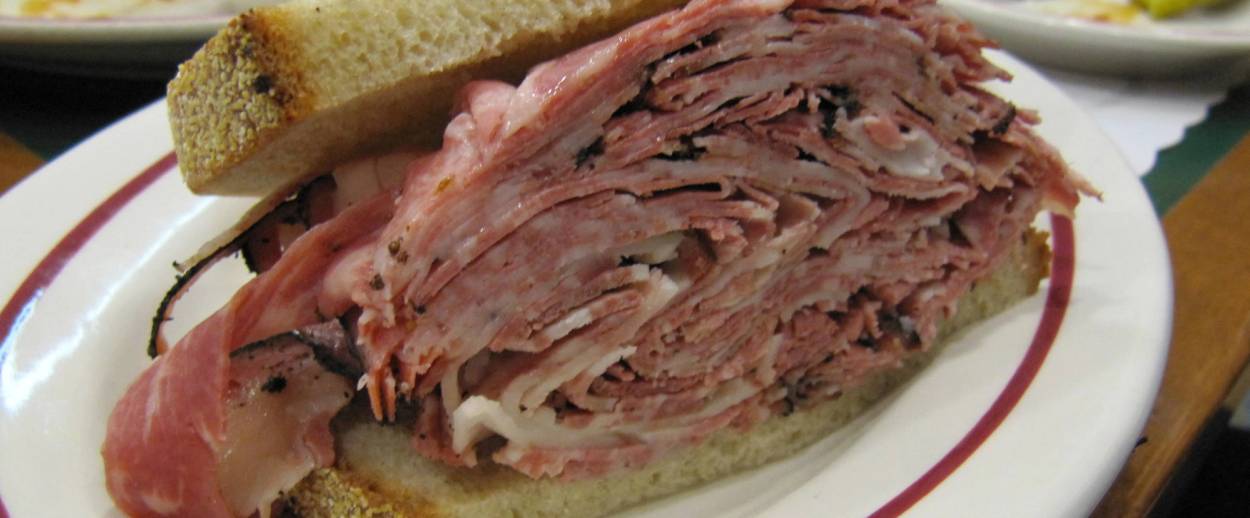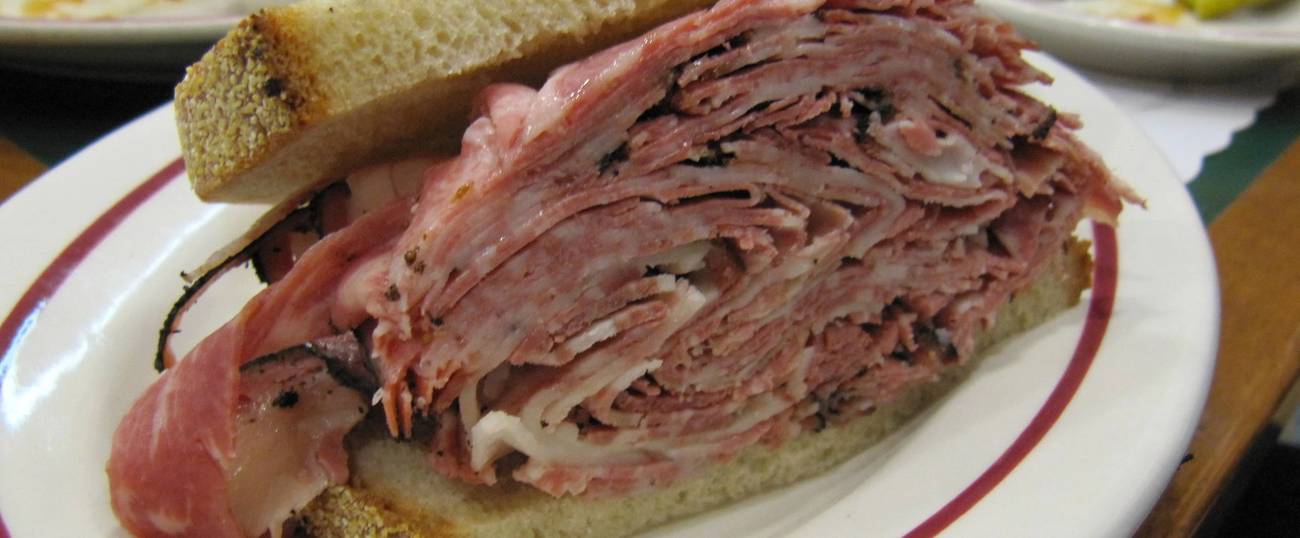On the Rolled Beef Trail
The quest for a forgotten deli delicacy led me from Tucson to Buffalo to New York City




I thought I knew everything there was to know about kosher cold cuts. And then I encountered rolled beef.
I first became aware of this deli delicacy when several references to it turned up in the comments section of an obituary I’d posted on my Jewish genealogy blog, Freud’s Butcher. Typical of the glowing tributes to 97-year-old Nathan Kornmehl, a Buffalo, New York-based cousin I’d never met, was one from a nephew: “When I think of Nate, I think of his butcher shop—he seemed to be always there, always with a smile and a kind word. And always, with a slice or two of rolled beef to brighten up a kid’s day.”
I grew up in Brooklyn in an era when delis were not yet an endangered species. How was it that I—and the childhood friends I queried—had never heard of Nathan’s nachas-inducing specialty? Was it just a Buffalo thing?
I posted the limited—and often contradictory—information I could find on this subject on my blog. Most of the corresponding comments were long on reminiscence, short on history and recipes. Typical was an observation by Helene M., who said rolled beef was her favorite at her father-in-law’s deli in Brookline, Massachusetts: “I did also love pastrami, but it was much fattier.” In contrast, Deb D. recalled the rolled beef of Irving’s Deli in Brighton Beach, Brooklyn, as having “seasonings that were similar to but a bit less spicy than pastrami,” and describing it as “more or less an inexpensive luncheon meat.”
Happily, Harvey Feinman, a butcher in Buffalo for 16 years, was also among the commenters.
Feinman began working for Brown’s Kosher Meat Market in 1958, when he was 17 years old. He recalled that they made rolled beef in the store every Friday, and that it retailed at $1.60 per pound (“People screamed when we raised the price to $1.80”). In comparison, corned beef cost $6 to $8 a pound.
Rolled beef was a less expensive corned beef substitute, according to Feinman.
He explained, “If you picture the kosher forequarter of the steer, there are breasts on each side. That’s the brisket cut. Below that, near the stomach, is the navel, the fattier and cheaper cut.”
Corned beef and, of course, brisket, are made from the brisket, while pastrami, like rolled beef, comes from the navel, sometimes called the plate.
Each navel is about 20 inches long. After removing most of the fat, Feinman said, he would layer the thinned-out slab of meat with leftovers—”any kind of beef, but it had to be lean”—saved up during the week. He rolled it all up together carefully, securing the resulting cylinder with string.
It was then brined in a solution of salt, water, saltpeter (potassium nitrate, a curing agent no longer used), and mixed spices—each butcher had his own formula—in a large wooden barrel for six weeks. After boiling it for three hours and cooling it overnight, it was ready for the deli slicer. “Sometimes the string was pulled off as you sliced it, but if the meat was rolled tight enough and didn’t fall apart, you pulled it off before,” Feinman said.
Feinman, who left Buffalo in 1976, called Nathan Kornmehl “the last of the Mohicans,” the final one of the city’s kosher butcher klatch to retire, in 1989.
Rolled beef wasn’t found only in Buffalo. Anecdotal evidence suggests that, throughout the 1970s and into the 1980s, rolled beef could be found in Jewish enclaves throughout the Northeast, with sightings as far away as Florida, Ohio, and Toronto, sometimes under such aliases as “spiced beef” and even “navel corned beef.” From the 1990s onward, however, New York City was the cold cut’s sole reported locus.
*
All this research whetted my appetite for a taste of rolled beef. But that proved easier said than done.
I now live in the deli desert of Tucson, Arizona. In order to get the authentic, in situ experience, I needed to wait for my next trip back east. Not only does overnight shipping cost half the price of a one-way ticket to the city, but deli tastes different when you’re not surrounded by a roomful of people talking loudly.
In addition, my choice of rolled beef venues was limited. I’m not observant but my cured-meat maven friend Martha, essential to my sampling plans, kept kosher. This eliminated Sarge’s Jewish-style deli in Manhattan from consideration. The 2nd Ave Deli listed rolled beef on its menu but couldn’t promise it would be available when I was in town. Only Ben’s Best Kosher Delicatessen in Rego Park, Queens, assured me they always carry it.
This turned out to be the result of blatant cold-cut cronyism. For many years, A to Z Kosher Meat Products (aka Grand Kosher) in Williamsburg, Brooklyn, was the city’s only commercial supplier of rolled beef. A to Z owner Eddie Weinberg was a close friend of Jay Parker, the owner of Ben’s. Because rolled beef takes so much time to make, Weinberg was sparing with this deli delicacy, rarely selling it to anyone besides Parker.
Parker joked, “When you owe someone as much money as I owe Eddie, he has a vested interest in keeping you in business.”
On a trip east in 2014, I trekked out to Weinberg’s huge kosher meat warehouse in Brooklyn to get his recipe, which he traced back to his grandfather, a butcher in Germany. His rolled beef process tracked with Feinman’s—up to a point. Weinberg removed the fat from three pieces of navel beef, then sewed the resulting thin slabs from each of them together, end to end. After curing and spicing the resulting beef quilt, he rolled it up tightly, tied it together, and smoked it.
Weinberg laughed about Parker’s reliance on his rolled beef: “When we didn’t have it for him for a few weeks, we thought we were going to have to find Jay a rolled beef therapist.” But Parker recalled an earlier story about the cold cut from his father, Benjamin, who opened the Rego Park institution in 1945: “In the old days, labor was cheap but merchandise was expensive. When the deli men were standing around with nothing to do, they took the trimmings from the pastrami, rolled them up, and tied the whole thing together.”
This would explain the disparities in recollections—and prices. Rolled beef seems to have two parallel origin stories, one going back to Europe that didn’t involve scraps, the other a New World variation on pastrami that did. In addition to the consensus that it’s always served cold and that navel beef is the cut used, all agree that creating rolled beef is labor intensive—thus its near demise in an era of mass production and scant demand.
*
Now that I knew about the history of rolled beef, it was time to try it. So I went to Ben’s and placed my order, with nervous anticipation.
My food finally arrived—two slices of rye piled high with the elusive cold cut. I took a small bite and chewed slowly, trying to locate this deli delicacy in the ranks of better-known Jewish charcuterie.
My verdict: Rolled beef is similar to pastrami in texture, moist but with less fat. I had a harder time deciding about the spices. The edges were peppery and garlicky, yes, but a bit milder than pastrami, closer to corned beef.
The sandwich was as satisfying to the Jewish soul as great deli can be, but for me, it was missing one key ingredient: the savor of nostalgia. Unlike those for whom rolled beef is the cured meat equivalent of Proust’s madeleine, I only had secondhand reports of what it was and how it was made up until that day.
*
I would have put my deli quest to rest, secure in the knowledge that there were at least three keepers of the rolled beef flame, had I not been alerted to the fact that both A to Z and Ben’s closed their doors in 2018.
And then there was one: Sarge’s.
Abe Katz, a sergeant in the NYPD, opened Sarge’s Delicatessen and Diner in 1964. It is now in the hands of Katz’s great-grandson, Andrew Wengrover, and Steve Thall, Wengrover’s father-in-law and business partner.
According to Thall, all the deli meats are made on the premises using recipes brought over from Eastern Europe by Katz’s grandparents. Thall described Sarge’s rolled beef process as being similar to that of Eddie Weinberg, except without the sewing together of the navel beef pieces.
Thall, who estimates that the kitchen produces some 20 pounds of rolled beef a week, said they will continue to make it as long as they get requests. Not surprisingly, almost all the orders come from older customers, including many from different parts of the country who get it air-freighted overnight.
David F. wrote on the restaurant’s website, for example: “All of the delis I have used over the years have dropped authentic rolled beef from their menus. I found Sarge’s Deli still had it listed and tried it twice now. It is wonderful, the stuff of my youth.”
Also, Thall said of keeping rolled beef on the menu: “It got you to call us, didn’t it?”
It did. I plan to head over to Sarge’s the next time I’m in town. Martha, my kosher-keeping fellow deli sampler and dear friend, has since died of cancer. I now have the memory of our earlier tasting together to add complexity and depth to my rolled beef’s flavor.
***
Like this article? Sign up for our Daily Digest to get Tablet magazine’s new content in your inbox each morning.
Edie Jarolim writes about food and travel for a variety of national publications, and blogs about genealogy, psychology, and meat on FreudsButcher.com.